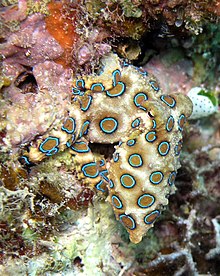
Numerous animal species naturally produce chemical toxins which are used to kill or incapacitate prey or as a defense against predators. Venomous animals actively deliver their toxins (called venom) into their target through a specially designed mechanism, such as a bite or sting, by using a venom apparatus, such as fangs or a stinger, in a processes called envenomation.[1][2] They are often distinguished from poisonous animals, which instead passively deliver their toxins (called poison) to their victims upon contact such as through inhalation, absorption through the skin, or after being ingested.[1][2][3] The only difference between venomous animals and poisonous animals is how they deliver the toxins.[3] This list deals exclusively with venomous animals.
Venoms have adapted to serve a wide variety of purposes. Their intended effects can range from mild fleeting discomfort to paralysis and death, and they may be highly selective in which species they target, often making them harmless to all but a few specific organisms; what may be fatal to one species may be totally insignificant to another species. Because the definition of "venomous" can be extremely broad, this list includes only those animals with venom that is known or suspected to be medically significant for humans or domestic animals.
- ^ a b Gupta, Ramesh C. (24 March 2017). Reproductive and developmental toxicology. Saint Louis. pp. 963–972. ISBN 978-0-12-804240-3. OCLC 980850276.
{{cite book}}: CS1 maint: location missing publisher (link) - ^ a b Chippaux, JP; Goyffon, M (2006). "[Venomous and poisonous animals--I. Overview]". Médecine Tropicale (in French). 66 (3): 215–20. ISSN 0025-682X. PMID 16924809.
- ^ a b "Poison vs. Venom". Australian Academy of Science. 3 November 2017. Retrieved 17 April 2022.